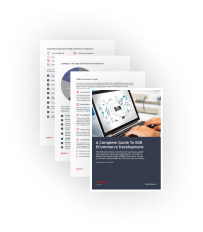Chinese websites for shopping are growing faster than anywhere else. Online retailers from China have been holding the largest global market share in 2024-2025, with online market sales reaching approximately 15.5 trillion yuan (about 2.16 trillion U.S. dollars) in 2024. This marks 12 consecutive years of China leading worldwide in online retail volume (The State Council of The People’s Republic of China).
With digital trade booming in China, many wonders how to get in on the action. The rise of China’s eCommerce market has created unique opportunities for both local and international sellers. The answer? Chinese online marketplaces. Our article explains what they’re all about, how to pick the right one, how to start selling, and how to learn from others’ experiences.
Key Features of Chinese eCommerce
Before diving into the world of China marketplaces, it’s crucial to grasp the market’s unique characteristics and the mindset of its people. The Chinese online market is vast and rapidly expanding. Chinese employees are known for their efficiency, but as partners, they tend to be cautious and skeptical. As consumers, they’re famously demanding, sometimes even picky. With over 1.04 billion internet users, 812 million of whom shop online regularly, and a yearly growth rate of 10%, it’s no surprise.
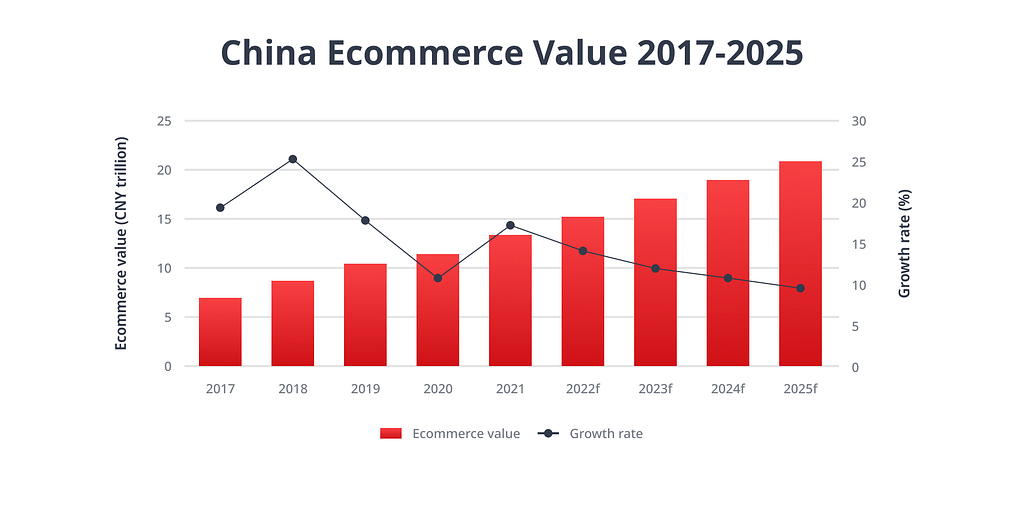
China eCommerce Value by Global Data Banking and Payments Intelligence Center, 2024
Online sales in the Chinese market have surpassed traditional retail, and ordering ready-made meals for delivery has become so common that many homes don’t even have kitchens anymore.
Here are some key aspects of eCommerce in China:
- Competition and ecosystems. Online business in China is centralized around the digital giants BAT – Baidu (a search engine similar to Google), Alibaba (the largest eCommerce company in China, including about 700 subsidiaries), and Tencent (a digital services corporation). An aspiring startup must integrate into one of the ecosystems of monopolists. Otherwise, it simply will not survive.
- Mobile dominance. The majority of Chinese users purchase goods through smartphones. This requires Chinese eCommerce websites to optimize their interface and functionality for mobile screens.
- Social media integration. Sellers shorten the path to the client and allow them to purchase goods or services by scrolling through the news feed or viewing reels on the social networks WeChat, Weibo, and TikTok. Chinese online shopping platforms facilitate this seamless purchasing experience.
- Changing user behavior. Buyers increasingly prefer to use short video services of social networks rather than search engines to look for the necessary information.
- Regional variation. China is a big country. A budding entrepreneur will not be able to reach the country’s entire audience, so they should target residents of individual macro-regions, especially since their interests and needs are very different.
- Marketplace preference. Chinese online stores are becoming a thing of the past. Customers use them when buying products from big brands or looking for highly specialized products. Customers use online stores when buying products from big brands or looking for high-quality products, while they turn to marketplaces for variety and lower prices. They go to marketplaces – electronic trading platforms with many merchants – for everything else. There, they get access to a vast assortment of items, bonus programs and discounts, as well as budget collective purchases (their essence is simple: one person creates an ad on the platform that they want to purchase a particular product/service, others join, and when they get enough participants they can buy the item at a reduced price).
As of 2025, mobile commerce continues to dominate, supported by seamless integration between super‑apps like WeChat, Alipay, and Douyin. Chinese consumers increasingly rely on AI-curated recommendations, virtual try-ons, and livestreams rather than traditional product listings. Brands must optimize content for short video platforms and embrace influencer collaborations on Douyin and Xiaohongshu to remain competitive.
Now let’s talk about the Chinese websites themselves: what are their features and what you need to be prepared for when entering multivendor platforms.
Pros and Cons of Selling on Chinese Online Marketplaces
Collaborating with Chinese marketplaces comes with its own set of considerations, shaped by cultural norms, socio-political dynamics, dense population, and high digitalization levels. Yet, the chance to access such a lucrative market is worth the challenges. Before diving in, it’s crucial to weigh the pros and cons of such an investment.
Pros
- Sales boost. With over 1 billion online consumers, both in China and internationally, the potential to find buyers is significant.
- Low seller commissions. Typically ranging from 2-10%, much lower than those on American and European platforms.
- Ease of use. China marketplaces offer intuitive tools for listing, selling, and promoting products, often with automatic translation and multi-country payment support.
- Fulfillment services. Chinese websites typically handle packaging, labeling (such as cosmetic labeling requirements), storage, and delivery, streamlining the process for sellers.
- Access to technology. Collaboration provides access to cutting-edge digital solutions, enhancing business efficiency and competitiveness.
- Government support. State programs and free trade zones offer tax breaks, low export duties, and less strict currency controls, fostering a favorable business environment.
Cons
- Cultural and visual adaptation requirements. Unlike Western markets, Chinese product listings must often include vibrant visuals, stylized product videos, and culturally resonant symbols. Without localized creatives and marketing, sellers may struggle to gain traction.
- High competition. Chinese marketplaces employ millions of sellers from all over the world. This means an entrepreneur must promote products or services with few analogs. It is better to give preference to locally produced goods.
- Price pressures. To remain competitive, entrepreneurs often need to reduce prices significantly and adopt competitive pricing strategies.
- Return challenges. Returns are common, and sellers may lose profits if they haven’t included transportation costs in their prices
- Language barrier. Product descriptions and customer communication must be in Chinese, requiring professional translation due to dialect variations.
- Counterfeits. China is a country where it is easy to “copy” the desired product. The biggest Chinese online retailers are fighting unscrupulous sellers, but intellectual property infringement is a risk despite efforts to combat it.
When entering the Chinese market, be prepared to plunge into a new reality: the way of life, traditions, and customs of Asian countries are fundamentally different from Western ones. This is reflected in literally everything: from the culture of negotiations with trading partners to the design features of product cards — people here love brightness and eccentricity, and video is a must for publishing an ad. It will take some time to adapt, but considering that marketplaces will give you access to a billion-dollar audience (not only Chinese but also other foreign countries who make purchases on Alibaba, Tmall Global and other platforms), it’s worth it.
Olga, Head of Sales and Customer Support at Simtech Development.
You may be interested in reading: The Real eCommerce Advantages and Disadvantages: Who Will Benefit From Online Business In 2025?
Types of Chinese Marketplaces
Choosing the right platform to sell your goods and services is a key decision for any business, especially when entering the Chinese market. Chinese online retailers can be broadly categorized into domestic and international platforms. Domestic platforms primarily cater to Chinese buyers, while international ones facilitate cross-border transactions, attracting users from various regions worldwide.
Domestic Chinese Marketplaces
Domestic marketplaces focus on Chinese buyers. Sellers whose business is registered in China or have a partner with a local passport and a bank account can cooperate with such platforms. Such conditions cause many difficulties for foreign entrepreneurs. Still, they are ready to solve them because the audience of many domestic trading platforms is larger than the population in their countries. Moreover, Chinese websites, like China-based online marketplaces, are accommodating to foreign businesses – they offer government support to those who want to open an enterprise in China or recommend certified specialists with a good reputation and experience working on the platform as local partners.
We will give examples of the most famous domestic marketplaces in China below.
Taobao
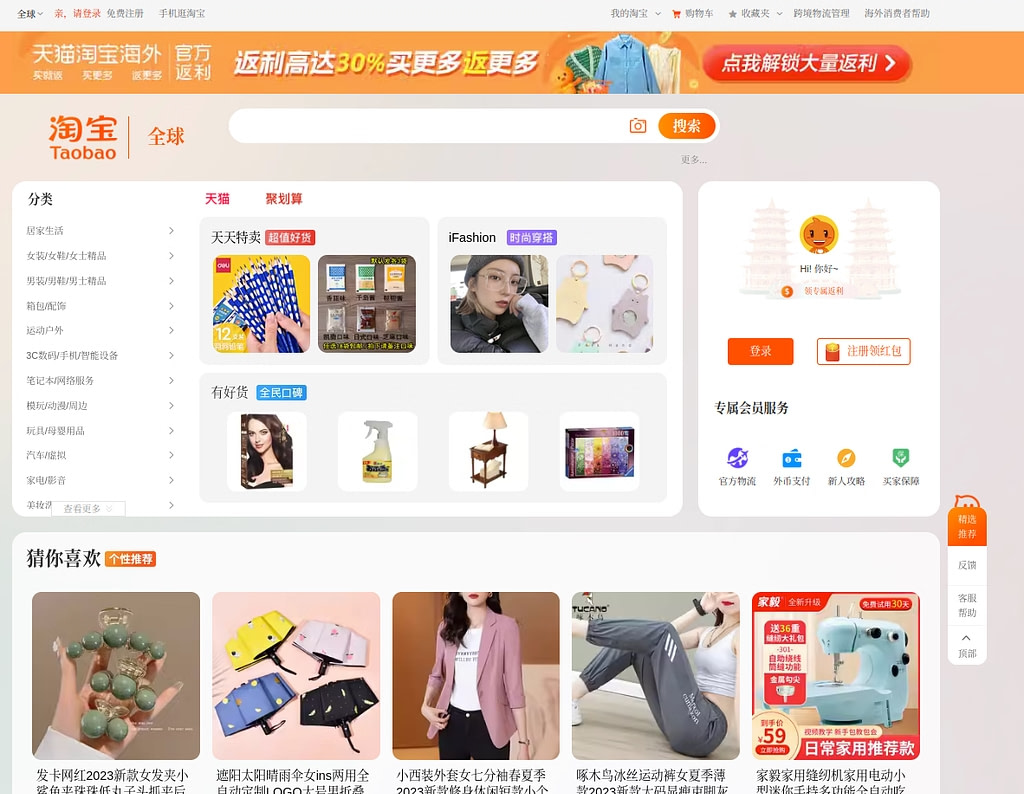
Taobao, the most popular Chinese buying platform, attracts over 900 million monthly users with everything from phone cases to industrial parts. The brainchild of the eCommerce corporation Alibaba, the Internet megamall, established in 2003, is a prominent Chinese marketplace. The marketplace sells goods in the B2C (business-to-consumer) and C2C (consumer-to-consumer) segments.
You can buy anything from phone cases to CNC machine parts on Taobao, a leading Chinese marketplace. And most importantly, at a relatively low price. Interestingly, the site’s operation principle is reminiscent of a traditional market, where buyers and sellers can bargain freely. The number of users on the site breaks all records – 900 million people per month.
From its inception, Taobao began to grow rapidly, and over time, large brands began to open stores in the marketplace. Therefore, in 2008, management launched a premium version of Taobao – Tmall, and later Tmall Global.
Tmall and Tmall Global
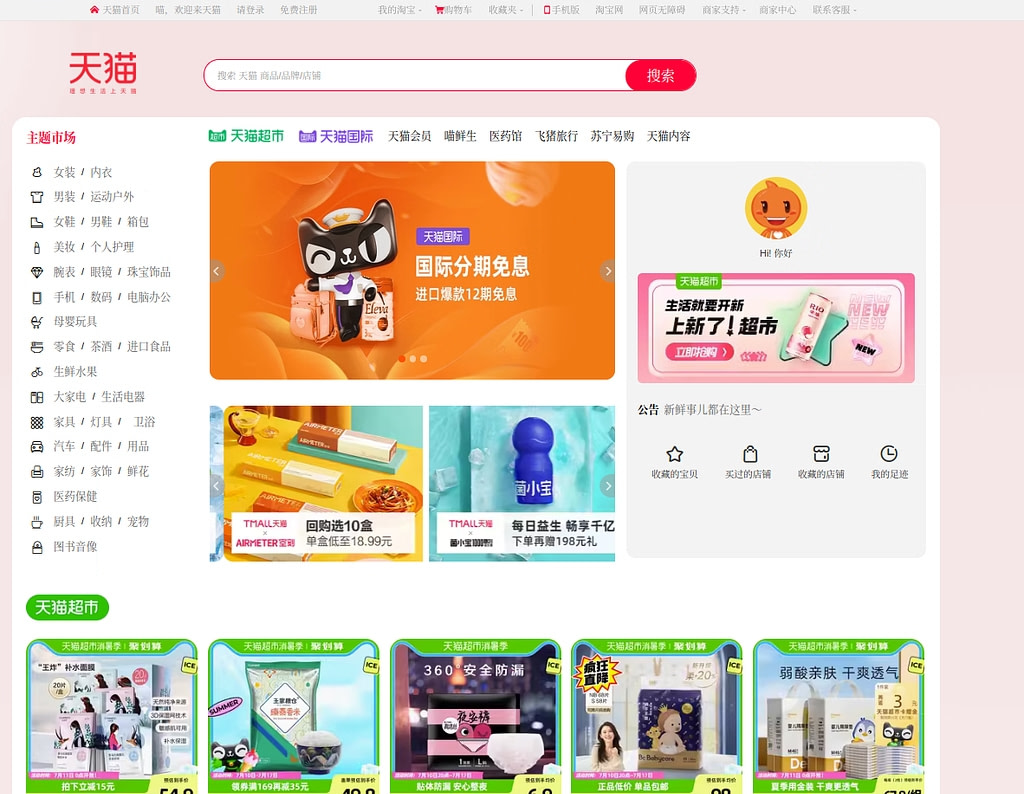
Tmall is aimed at large companies that sell well-known brands to Chinese consumers. This Chinese online marketplace is designed to deliver a premium shopping experience for buyers seeking quality and trust. The platform offers a huge range of offers from various categories: sports, cosmetics, textiles, cars and motorcycles, and food.
Today, the marketplace has more than 500 million users and 150 thousand sellers. For a long time, it was difficult for foreign companies to enter the eCommerce platform without a legal presence in China. In 2014 owners of Alibaba launched the global Tmall. According to the rules of the new site, it did not matter in which country the supplier was registered and whether they had an account in a Chinese bank. This is how European and American goods poured into Tmall Global. Tmall Global was launched to make it easier for foreign companies to sell international products directly to Chinese consumers.
Tmall Global currently hosts 20 thousand brands from 77 countries. Most are from the USA, Canada, South Korea, Australia, New Zealand, and Japan. Foreign companies receive their revenue in various currencies, including cryptocurrency.
Suning
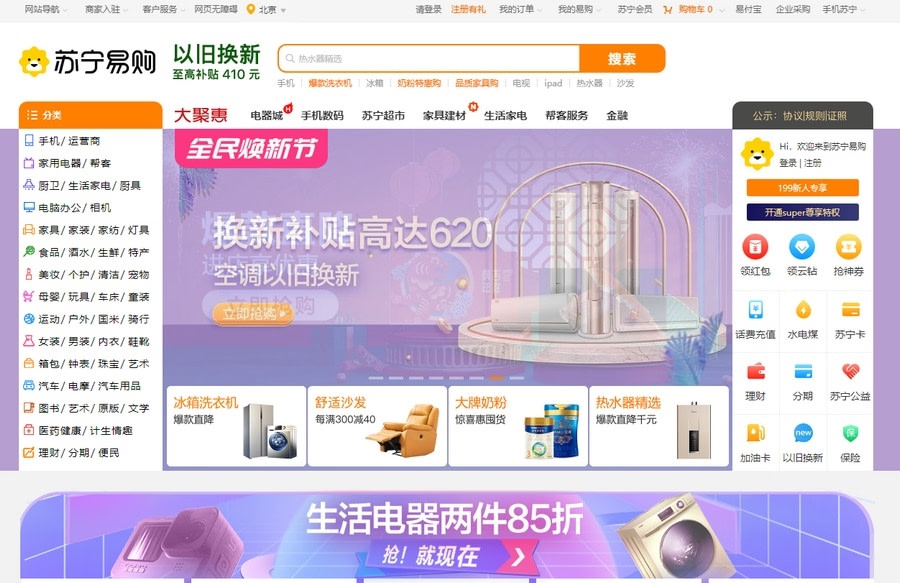
One of the largest Chinese wholesale websites, founded in 1996 for the domestic market. It has about 12 million monthly users and specializes in televisions, audio, video and consumer electronics, as well as computers and networking equipment. One can find products from Samsung, Sony, Panasonic, Fly, HTS, and ASUS here. Among other things, Suning sells clothing, textiles, food products, home furnishings, personal care products, cosmetics and perfumes.
When working with foreign partners, the marketplace offers two models of cooperation. The first is fulfillment, in which the platform provides store support, logistics and warehousing of the supplier’s goods. The second is a complete repurchase of products and independent sale of goods on behalf of the marketplace. One of the disadvantages of Suning is the lack of an English-language interface, and payments are made exclusively in yuan.
Kaola
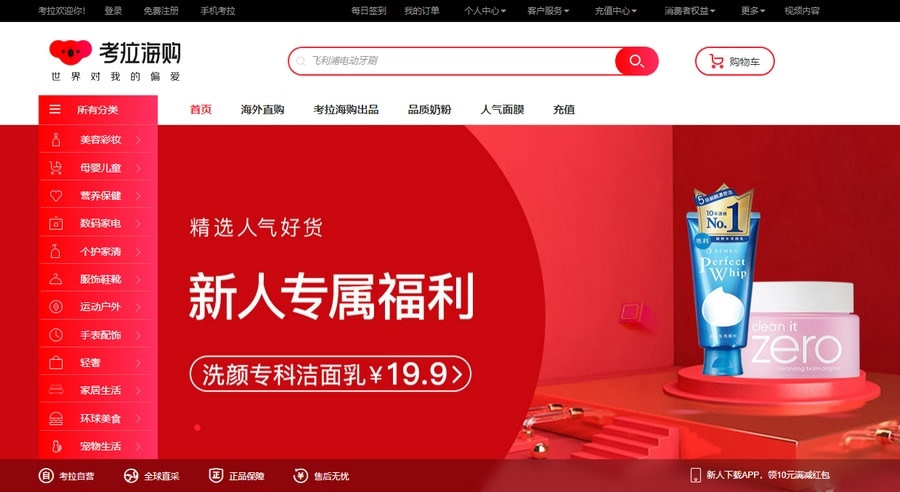
The marketplace was founded in 2015 by Netease and was intended for Australian companies that wanted to sell their products in China.
Kaola has over 30 million active users on its platform. It offers products for children, food, cosmetics, clothing and accessories. In 2019, the marketplace was sold to Alibaba Group, and since then, the geography of product suppliers has expanded to 80 countries. The marketplace provides foreign manufacturers with a full range of services for importing goods: logistics warehouses, cross-border payments, and assistance in promotion.
Poizon
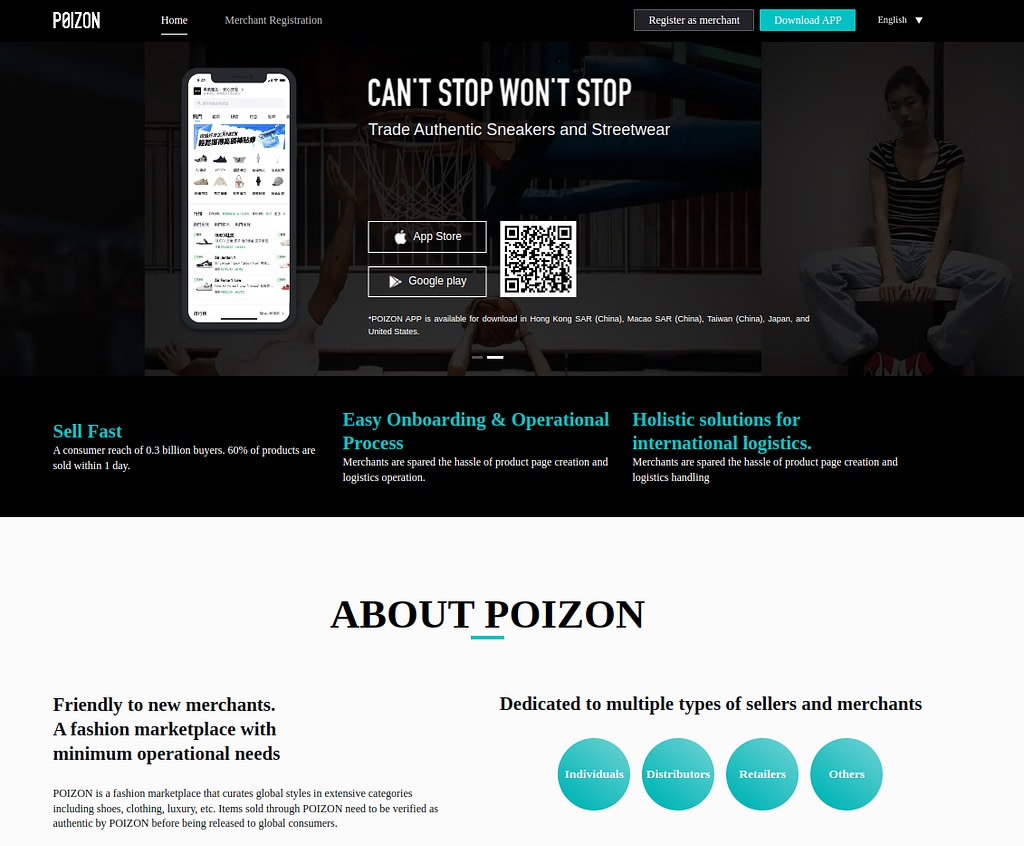
A Chinese marketplace launched in 2015 as an online community of sneaker collectors and street fashion connoisseurs. By 2022, it had developed into a full-fledged marketplace for branded and designer items, where, in addition to comfortable shoes, you could buy bags, accessories, cosmetics, perfumes, and electronics. Poizon is aimed at a young audience and is widely used on smartphones. The platform’s audience numbers over 100 million users, with 1.5 million using the app monthly.
One of the key advantages of the site is its multi-stage verification system. Before sending the goods to the buyer, Poizon specialists check the items for authenticity. For example, sneakers are evaluated according to 16 parameters: the sole, label, insole, and laces are examined. After this, the items are sealed with a branded clip with an identification number, and a certificate stating that the item has passed inspection is included and packed in a Poizon branded box.
1688
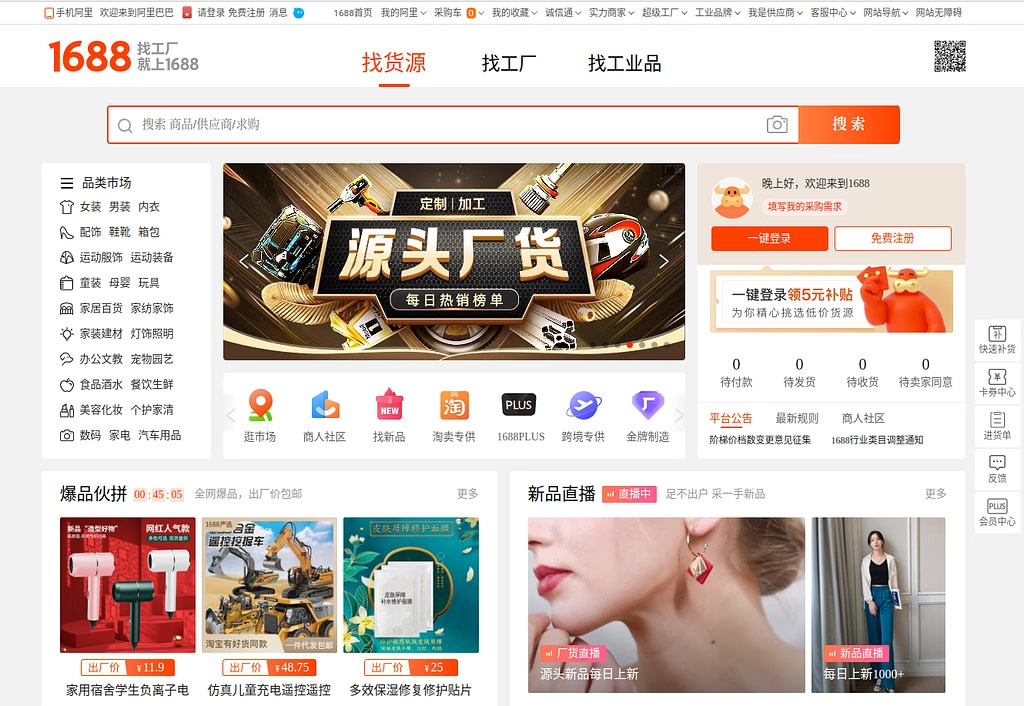
Another Asian online marketplace store owned by Alibaba, the largest B2B trading site. Intended exclusively for Chinese wholesale buyers who subsequently resell products worldwide, including on Amazon and eBay. 1688 is sometimes called the Chinese eBay equivalent, offering direct-from-factory deals with options for negotiation and bulk ordering.
Why does the site have such a name? 1688 in Chinese sounds like “Yi Liu Ba Ba”, almost like “Alibaba”, it has become the “little brother” of the global alibaba.com. The marketplaces are similar: the general business model and the wide range of products offered: auto products, plumbing, personal protective equipment, industrial and construction products, materials for beauty salons and much more. All these are supplies from factories. But unlike alibaba.com, the cost of products on “1688” is much lower because the marketplace defends the interests of Chinese consumers.
There are other “bonuses” for buyers: on the site, they can agree with manufacturers on product branding and changes in characteristics and packaging. When purchasing, money goes not directly to the seller but is “frozen” by the marketplace. The seller will be able to receive them only when the cargo reaches the customer and they do not open a dispute in due time.
Xiaohongshu (Little Red Book)

A hybrid between a social media platform and a marketplace, Xiaohongshu is particularly popular among Gen Z and millennial consumers for fashion, beauty, and lifestyle products. It plays a major role in China’s social commerce landscape, where users share reviews, create tutorials, and shop directly from posts. Its influence rivals traditional marketplaces for certain verticals.
Douyin

Originally known for short videos, Douyin (TikTok China) has evolved into a standalone eCommerce ecosystem where brands sell directly through live streams, mini-programs, and in-video shopping links. It’s a leader in entertainment-based commerce, integrating algorithmic content feeds with seamless product discovery and purchase options.
VIP.com
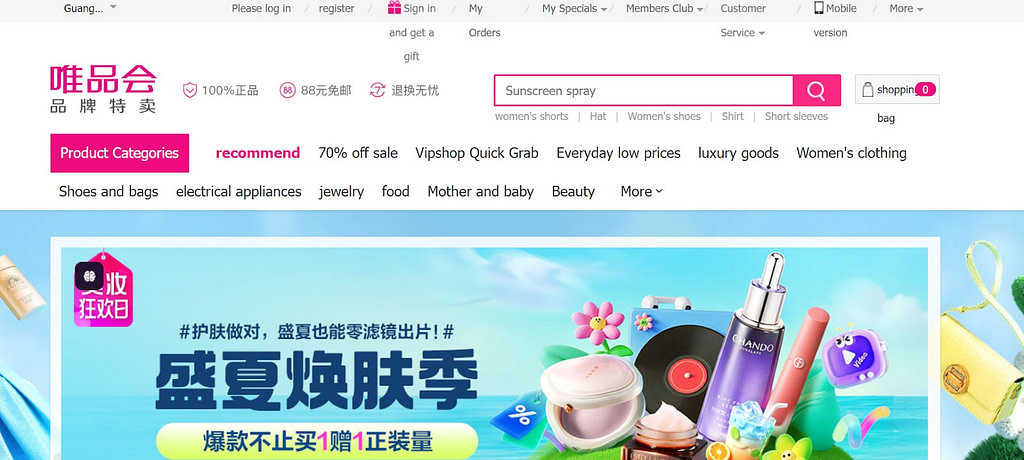
It is one of China’s largest online retailers specializing in flash sales, offering significant discounts on branded items for a limited time. VIP.com operates under a curated sales model, making it attractive for premium brands and time-sensitive inventory.
Domestic marketplaces in China are large trading platforms where both local and foreign sellers can sell, but only Chinese residents can buy. Such platforms satisfy the population’s demand, expand the range of available goods and services, and promote the development of domestic trade.
International Chinese Marketplaces
International Chinese marketplaces cater to consumers and suppliers from various countries, offering opportunities for cross-border trade. Unlike domestic platforms, registration requirements for foreign sellers may vary. While some platforms may only require foreign passport information and licenses for goods, others may mandate a Chinese bank account or the presence of a local representative. Let’s explore some of the most popular international platforms:
Alibaba

Alibaba is one of the first eCommerce platforms in China and the world’s largest online marketplace, specializing in the wholesale trade of products in various categories: electronics, equipment, building materials, household goods, car parts, etc.
This Chinese Amazon equivalent was launched in 1999 by Alibaba Group as a space for interaction between entrepreneurs from different countries. On the platform, they can contact directly: conduct negotiations, order product samples, and arrange delivery.
Today, Alibaba provides access to its site to 190 million buyers worldwide, and the site is translated into 15 languages. This applies to the interface and the chat, where you can easily communicate with company managers through automatic text translation.
JD

Jingdong Mall is one of Alibaba’s main competitors. The platform was created in 1998 by JD Multimedia, now JD.com Inc., and initially dealt with magnetic and optical media. Then, it expanded the range to electronics, phones and household appliances. This category of goods remains the main one today, although you can also purchase clothes, shoes, hygiene products, toys for children and much more on the site.
The main advantage of JD is the most modern logistics infrastructure of all Chinese eCommerce platforms. It contains 1,300 warehouses, more than 7,200 delivery points, and about 200,000 courier service employees. It practices the delivery of goods using robots and drones.
The marketplace’s audience is almost 500 million users and more than 100 thousand sellers. There are support programs for foreign brands. JD started as a domestic marketplace, but since 2012, it has expanded its activities and offers goods and services in China and abroad.
AliExpress
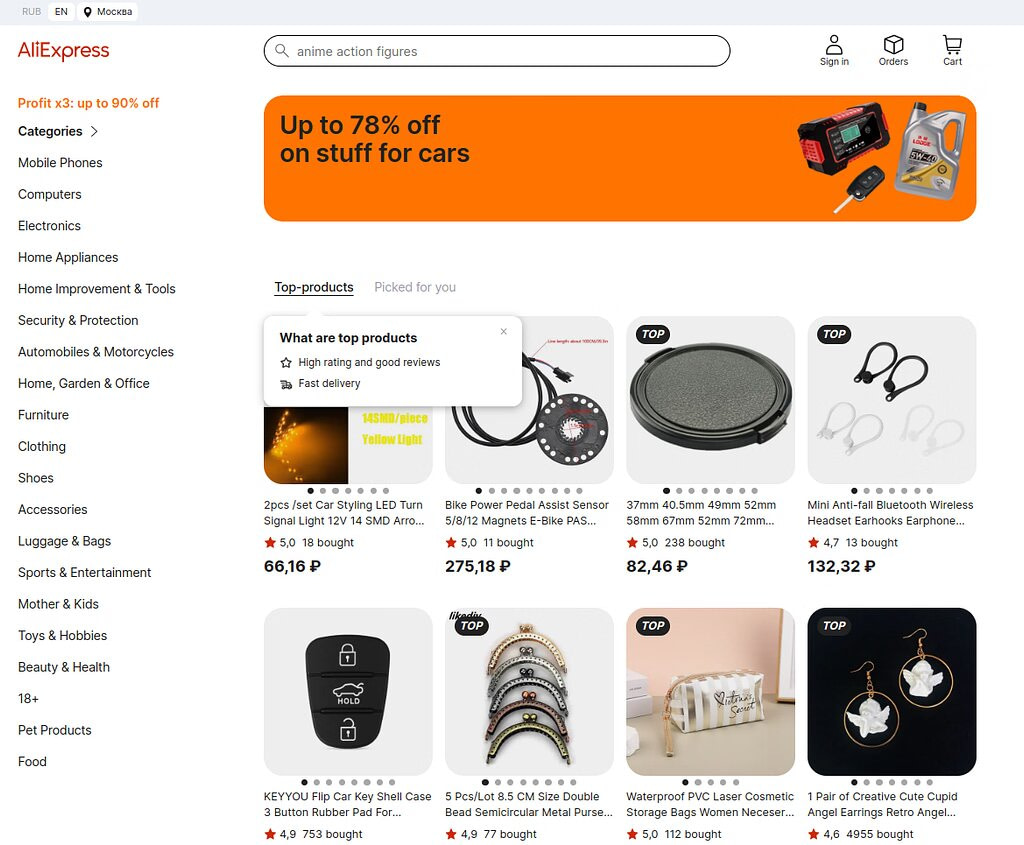
Another online store of Alibaba Group. It allows buyers from all over the world to purchase goods directly from manufacturers and sellers from China, Europe, the USA, and Turkey.
Chinese websites like Aliexpress offer products in various categories at low prices, making it a popular online shopping destination for over 100 million shoppers. Moreover, many sellers provide free delivery of goods to other countries. One of the features of AliExpress is the ability to purchase wholesale and retail goods. The platform also provides various payment methods, including credit cards, bank transfers, and electronic payment systems.
The marketplace’s clients are residents of 230 countries, so the content on the store’s website is automatically translated into 18 languages (Polish, French, Italian, English, Russian, Dutch, Arabic and others).
Pinduoduo

A marketplace focusing on an audience that accesses the Internet from a smartphone. Especially for this purpose, the site owners developed the Temu mobile application. Pinduoduo was founded in 2015 by a former Google engineer named Huang Zheng, who immediately fell in love with many users thanks to its low prices and group buying function. This applies not only to non-perishable goods (clothing, shoes, tools), but also to farm products, which customers can receive within a couple of hours after paying for the order.
Thanks to this, the marketplace has become one of the fastest-growing online marketplaces in China and has a huge base of active users, more than 800 million people monthly and more than 300 thousand sellers. The latter are attracted by the soft terms of cooperation with the platform: it does not take commissions on sales but receives its profit through advertising.
The platform is also actively developing outside of China. Since 2020, it has been used by customers from the USA, Great Britain, Germany, the Netherlands, Italy, France, Spain, Austria and Mexico. The marketplace plans to increase its presence in all 27 EU countries.
Made-in-China
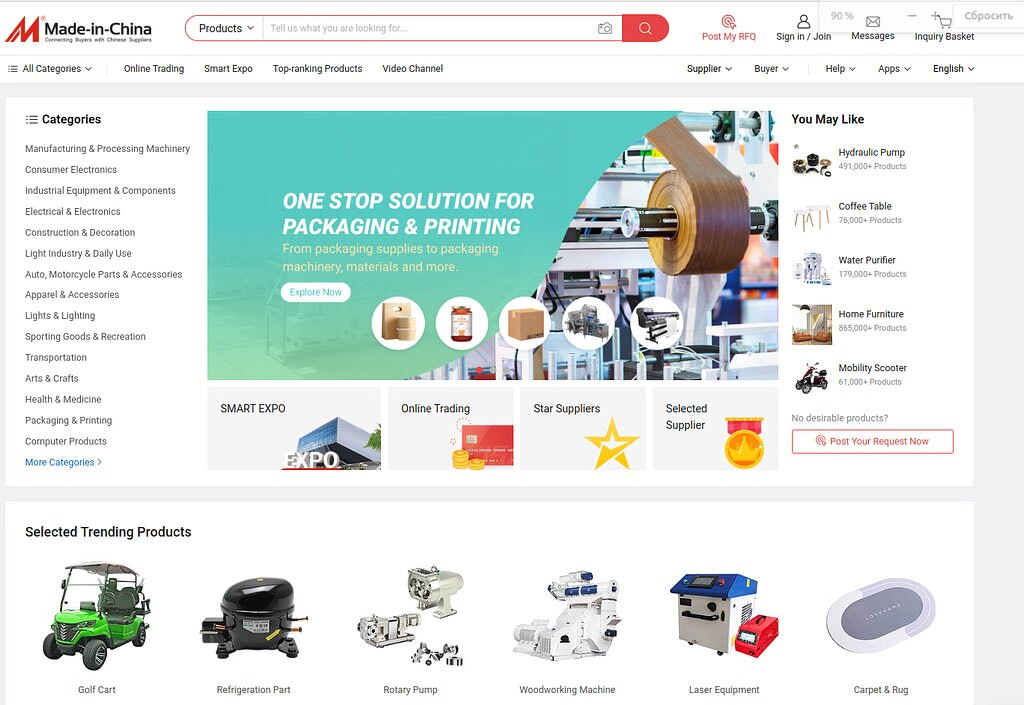
This Chinese B2B marketplace specializes in the trade of industrial equipment, auto parts, building materials, household goods, recreation and sports. As the name suggests, Made-in-China presents exclusively to Chinese manufacturers, and the platform acts as an intermediary between Chinese sellers (large importers, factories, and trading companies) and foreign buyers.
The platform has a simple interface and supports 11 languages, greatly simplifying searching and communicating with suppliers. You can search for products by categories, keywords, and—surprisingly—provinces of China.
Users can conduct online transactions directly on Made-in-China. This includes requests for quotes, price negotiations, ordering and payment. In addition, the marketplace boasts a panoramic factory tour with a demonstration of the production process.
SHEIN
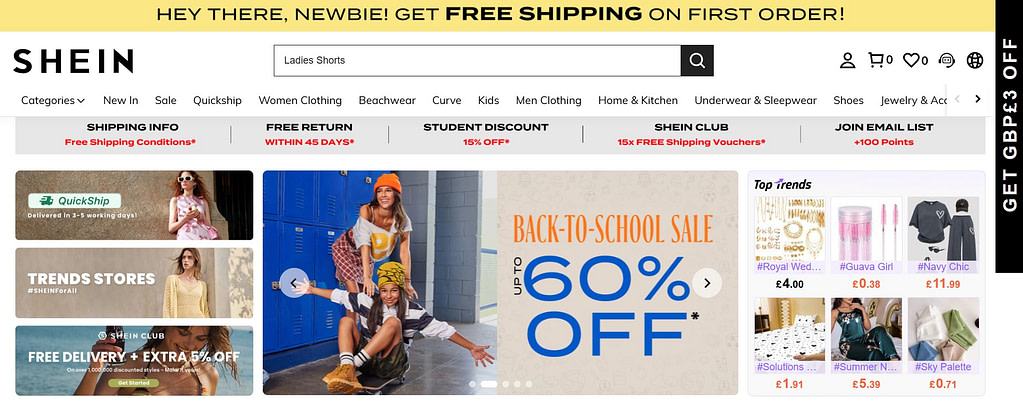
Although not a traditional marketplace, SHEIN is one of China’s most dominant online fashion retailers operating on a global scale. It follows a direct-to-consumer model with ultra-fast supply chains and app-first engagement. Foreign sellers can learn from SHEIN’s demand-driven design and agile production practices.
How to choose a suitable marketplace and launch sales
Read more at: Global Marketplaces — Best Online Marketplaces 2025
How to Choose a Suitable Marketplace and Launch Sales
To choose the right marketplace and set up your sales strategy, start with a thorough market analysis. Consider your target audience, competitors, and these key questions:
- What is the best Chinese marketplace to sell my products or services?
- What are the supplier requirements, such as documents, certificates, or partnerships in China?
- How financially viable is trading on the platforms? Compare commissions, advertising costs, and warehouse storage fees.
- What support programs or bonuses do the marketplaces offer?
Contact the marketplaces to gather precise information and submit your application once you’ve made your decision. Once approved, you can:
- Create a mini-store from scratch
- Integrate data from an existing online store to simplify product listings. The Simtech Development team can perform data integration work for you.
Next, arrange the product delivery to the marketplace warehouses. Once everything is set up, launch your store and focus on continuous product promotion using the marketplace’s tools and capabilities.
Entering Chinese marketplaces for entrepreneurs is a unique opportunity to enter global markets and also gain invaluable experience. China is a technology leader that uses advanced IT solutions on its trading platforms. Understanding them, mastering them and adopting them means gaining a competitive advantage in the digital trade market.
Andrew, CTO at Simtech Development.
When evaluating a marketplace, consider key factors such as your target audience demographics, product category alignment, fee structures (including commissions and advertising costs), available logistics and fulfillment services, and the level of cross-border support provided.
Platforms like Tmall Global and JD Worldwide, for instance, offer extensive infrastructure for foreign sellers, while Douyin and Xiaohongshu may be better for brands focused on community-driven growth.
B2B vs B2C vs C2C: What Works for Foreign Sellers
Foreign sellers often find the B2C model (via platforms like Tmall Global or JD Worldwide) most accessible due to robust support for cross-border commerce and brand control.
B2B platforms like Alibaba or 1688 are suitable for manufacturers and wholesalers targeting bulk buyers.
The C2C model, dominant on platforms like Taobao, is less feasible for non-Chinese sellers due to language, payment, and residency requirements.
Top 10 Advanced Technologies of Chinese Marketplaces
Let’s look at the most interesting and significant technologies used by Chinese marketplaces. Perhaps you would like to use them in your current project?
1. Streaming Trading And Integration With Streaming Services
Imagining a Chinese marketplace without entertaining and selling video content is impossible. Sellers or specially invited bloggers record commercials or broadcast in real-time, demonstrating products that users can purchase on the marketplace. JD, Pinduoduo, Suning, and many other sites do this. Streaming has turned online shopping into entertainment and is now very popular among shoppers. Live Commerce combines streaming and eCommerce seamlessly, creating engaging shopping experiences that drive higher conversions.

Simtech Development also has experience in such integration. Recently, for one of the banks in Kazakhstan, we created a mobile application with a built-in streaming service. This is how the bank finds common ground with the youth audience and attracts new clients.
2. Big Data & Predictive Analytics
Chinese marketplaces leverage big data to anticipate trends, personalize user journeys, and optimize stock and pricing strategies. For instance, Alibaba uses predictive analytics to determine product demand per region, while JD.com forecasts delivery times and consumer behavior based on browsing and purchasing history. These tools allow sellers to tailor offerings with high precision.
3. Own Payment Systems
Large businesses launch not just online stores, but create ecosystems in which, in addition to trading platforms, there are many other products and solutions, including their own payment systems. For example, buyers of Alibaba Group marketplaces use Alipay. The system allows you to make online payments, transfer money, pay bills for services and mobile communications, buy transport tickets, and book hotels. Similarly, WeChat Pay and UnionPay are widely used payment solutions in China, providing seamless mobile and card-based transactions across various platforms and services.
4. Social Media Integration
Chinese marketplaces often integrate with social media platforms. For example, Taobao and Tmall, with WeChat or Weibo, have billions of active users worldwide. In addition, platforms like Douyin (TikTok China) and Xiaohongshu combine short-video content and social commerce, driving huge engagement and direct sales through entertainment. The technology allows customers to share their carts and reviews with friends and sellers to virally spread information about products and thereby increase sales.
5. Virtual and Augmented Reality (VR/AR)
Chinese marketplaces help customers try on clothes or accessories in a virtual environment before purchasing (Tmall) using advanced virtual try-on technologies, which allow shoppers to see how products look on them without visiting a physical store. You can also “overlay” interiors and virtual furniture onto a physical environment (Alibaba) or conduct virtual tours of properties (Fang.com).

Simtech Development implemented virtual glasses fitting for an online optics store SeeWhatHappensOnline from Belgium. Our team has integrated FitMix technology into the online store, allowing to recognize customers’ faces, select the frame size as accurately as possible, and display the person in a mirror. And all this in real-time.
6. Drones and Robot Couriers
JD has become one of the pioneers in using unmanned aerial vehicles to deliver goods to customers. The marketplace has developed its own delivery system using drones, which can cover significant distances and deliver orders weighing up to several hundred kilograms to remote areas of China.
JD also uses robot couriers. The vehicles can travel on sidewalks and roads to deliver goods directly to customers’ doors. They are equipped with navigation systems and sensors to navigate urban environments safely and avoid obstacles.
7. Virtual Assistants and Chatbots
Digital consultants are an essential part of Chinese marketplaces. They provide effective customer service and increase customer satisfaction. One of the most popular virtual assistants is AliMe from Alibaba. It uses artificial intelligence and neural networks to process customer queries and provide answers to questions about products, shipping, payment and other aspects of shopping.
JD also developed its own chatbot known as Jingdong Xiaoice. It can carry on conversations with users, recommend products, and even emotionally adapt to the user’s mood.
Read more at: Implementing Conversational Strategy: Does eCommerce Need Chats?
In addition to these AI assistants, WeChat mini-programs play a crucial role in supporting customers directly within the WeChat ecosystem, offering seamless access to services and personalized assistance powered by AI technologies.
Get more insights from: 25 Best AI Marketing Tools in 2025
8. Gamification Tools
Chinese marketplaces have many game mechanics to attract and retain customers. These are quests, wheel of fortune, and virtual avatars. This also includes comprehensive customer loyalty programs. For example, Alibaba Group has a program called Alibaba Points, where users can earn points by purchasing on the Alibaba platform.
Similarly, Pinduoduo uses social shopping features with interactive games to engage users, while Taobao incorporates fun activities like lucky draws and avatar customization to keep customers coming back.

Thus, at a client’s request from Hong Kong, Simtech Development developers created and integrated the Treasure Hunt game into the online store. The idea is simple: customers “travel” through the store pages, and when they reach the end, they receive a cash gift certificate, redeemable as a discount on a future purchase.
9. Use of Artificial Intelligence (AI)
Chinese marketplaces are actively using the capabilities of artificial intelligence. Alibaba, for example, uses computer vision to generate personalized offers for users, optimize pricing strategies, and deliver tailored recommendations. JD improves logistics efficiency while also leveraging AI-driven dynamic pricing and personalized product recommendations to enhance customer experience.
Meituan (a popular food ordering platform) optimizes delivery routes, forecasts makes user recommendations, and adjusts pricing in real time based on demand and customer preferences.
10. Super-App Ecosystems
Super-apps combine messaging, shopping, payments, social networking, and entertainment into a single interface. For instance:
- WeChat integrates brand stores, payments, CRM, and mini-programs.
- Alipay links eCommerce with financial services and insurance.
- Douyin lets users shop while watching influencers demo products live.
These ecosystems streamline the user journey, reducing friction and increasing conversion.
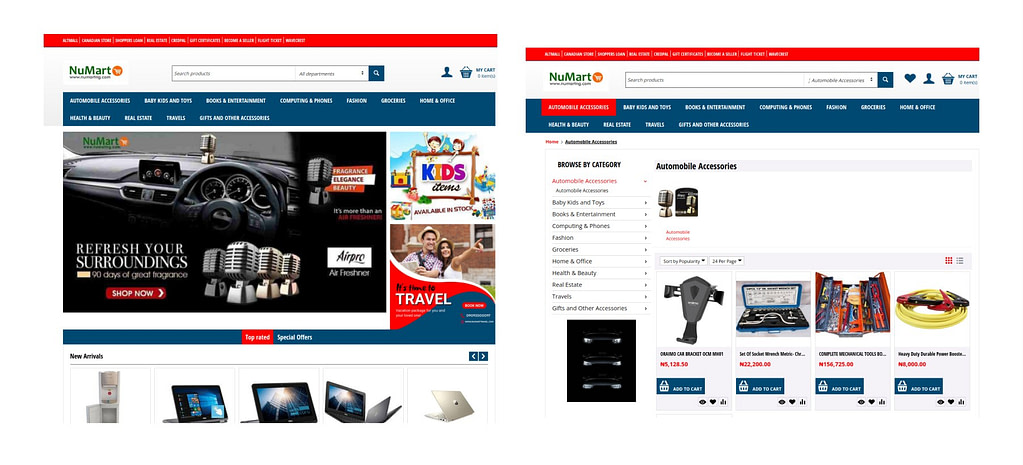
Simtech Development has integrated credit borrowing systems in several digital projects. One notable example is our work on the Numartng multi-product marketplace in Nigeria. This platform was designed to function both as a trading hub and a credit system, allowing customers to purchase expensive goods on installment plans. Simtech Development ensured that, during order processing, the system could calculate credit requirements, let users apply for loans, and automatically manage repayment in installments.
Learn more about advanced technologies from our posts:
- Why Use Laravel? Benefits for eCommerce site Development
- Headless CMS Development: Future of eCommerce that Comes Today
- 5 Best Enterprise eCommerce Platforms 2025: How to Choose Right Solutions for Your Business
Future Trends in Chinese Online Marketplaces
Trends drive growth. Let’s consider the novelties of 2025 to take advantage of.
Globalization of Chinese eCommerce
Chinese marketplaces are no longer just inward-facing. Platforms like Tmall Global, JD Worldwide, and AliExpress are welcoming international sellers and scaling cross-border infrastructure. Meanwhile, companies like Temu (by Pinduoduo) and SHEIN are aggressively expanding into the U.S., Europe, and Southeast Asia, often outpacing local players in price and variety.
Social + Entertainment Commerce
Douyin and Xiaohongshu are redefining how people shop by merging content, community, and commerce. Livestreams, influencer videos, and peer recommendations now drive purchasing decisions, supported by seamless in-app transactions and gamified experiences.
Sustainability & Green eCommerce
Both consumers and regulators in China now demand greener solutions. From biodegradable packaging to carbon-neutral shipping options, sustainability has become a key differentiator. Marketplaces like JD.com are rolling out green logistics programs, while the government provides incentives for eco-friendly brands.
Get more insights from: Sustainable eCommerce – Eco-Friendly Business Transformation
How to Start Selling on Chinese Marketplaces
Selling on Chinese eCommerce sites can open your business to a billion-strong digital market—but only if you enter prepared. From registration to logistics and promotion, each step requires both strategic insight and localized execution.
Registration Process for Foreign Businesses
Registration depends on the marketplace. Platforms like Tmall Global allow sellers without a legal entity in China, while others require a local presence. Typically, you’ll need a business license, identity verification, and proof of product quality or brand ownership, with all details varying by platform.
Product Localization & Cultural Adaptation
Success in China depends on more than translation. Product visuals must be bold, listings should feature video, and messaging should align with local festivals, social trends, and aesthetic preferences. Using native-speaking marketers is highly recommended.
Learn more from: Localization in China: How to Speak the Same Language with Your Customers
Payment & Logistics Setup
Sellers can use integrated systems like Alipay or WeChat Pay. Logistics may involve cross-border fulfillment centers, bonded warehouses, or partnering with a local 3PL provider. JD and Alibaba offer warehousing and end-to-end logistics.
Marketing Strategies for Chinese Consumers
Influencer marketing, short video ads, and in-app promotions drive sales. Utilize platforms like Douyin and Xiaohongshu, engage micro-influencers, and invest in banner placements or flash sale events. Loyalty and gamification tools also boost retention.
Learn more from: Top 10 eCommerce Growth Strategies to Maximize Sales
Wrapping up
China, as the world’s second-largest economy, prioritizes the development of eCommerce, fostering an environment conducive to digital innovation. This includes advancements in broadband Internet, digital infrastructure, mobile payments, and emerging technologies.
Marketplaces stand out as the cornerstone of online commerce in China, serving as highly effective platforms for trading. They can be categorized into domestic platforms catering to Chinese residents and international platforms serving consumers worldwide. These platforms boast millions of buyers and thousands of sellers spanning the globe. By incorporating advanced technology into your eCommerce platform, you can attract a broader customer base, ultimately driving sales growth.
At Simtech Development, our developers possess global expertise in eCommerce development and are equipped to implement various solutions tailored to your needs:
- Building a digital ecosystem
- Integration with external services, including streaming platforms
- Development of virtual reality-based solutions
- Incorporation of gamification elements into your website
- Creation of 3D models and product configurations
We look forward to collaborating with you. 再見! (See you soon!)
Read more:
